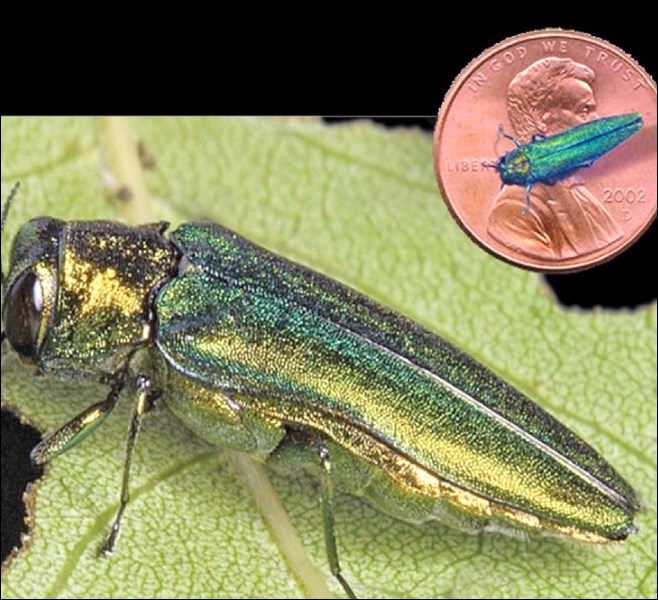“Invasion of the Emerald Ash Beetles” sounds like a title for a bad drive-in movie.
But for North Battleford’s urban forest the threat is all too real.
That threat comes from wood-boring beetles that could make their way to North Battleford from the east and destroy a good chunk of the city’s tree inventory in the near future. At City Hall Monday, city council members were presented with a comprehensive report on the situation from Director of Leisure Services Cheryl DeNeire.
The bug that concerns city officials the most is called the emerald ash borer. It is described as a “metallic, flat-headed, wood-boring beetle.” It is green and less than the size of a penny, therefore not easily visible.
It originates in Asia, but has come to North America and has been identified as far west as Winnipeg, where about a third of that city’s ash trees have been lost to the disease.
The emerald ash borer is described as an “emerging risk” over the next five years, with a priority described as “high.” It was also noted in DeNeire’s report that “disease or infestation” is not insurable.
The bug continues to travel westward “and climate doesn’t seem to hinder it,” DeNeire said. The emerald ash borer is known to infest every type of ash tree except mountain ash.
Once it infests a tree, the tree will die within two or three years. DeNeire reported more than 18 million ash trees have been lost to the bug.
What’s more, there is no long-term treatment reported, although there are measures to slow the infestation.
The greatest concern cited in the report was the threat to the city’s tree inventory. About 6,900 trees, or 30 per cent of the city’s tree inventory, consists of ash trees. Only a few of those are mountain ash.
There are another 6,900 elm trees and 350 weeping birch trees in the city. The other 8,050 trees, or 38 per cent, are varied.
“Our trees are a significant city asset,” DeNeire added. Losing the ash trees could cost the city between $1 and $1.5 million, she said.
Administration will be preparing a comprehensive risk management plan for their inventory, which will come back to council later on. This would be developed with specialist and arborist input and would cover all areas, including diversification and dealing with disease infestation.
As for dealing the emerald ash beetle, there are various options available, DeNeire indicated.
One option is injecting the ash trees with what amounts to a vaccine, but that would need to happen constantly.
“If you don’t continually put a booster shot in, it will become infested,” DeNeire said.
In Winnipeg, they are doing a combination of injections and letting other trees go, and it is still going to cost them $100 million, said DeNeire.
The hope is that some better way will be discovered to stop the problem with the wood-boring beetle.
“Its not a given that something won’t be found,” said DeNeire. She pointed to Dutch elm disease which at one point ravaged the elm population. In the old days, if a town got Dutch elm disease, it would lose all its elm trees. Now, DeNeire pointed out, there are ways to isolate that disease and prevent the other trees from being infested.
The urban forest has been a frequent topic of discussion at council this term, and the indication from council is they are supportive of the latest efforts by administration.
“This council is quite committed to our urban forest and wants to see whatever can be done to ensure that we preserve, protect and support the trees in our city,” said Councillor Len Taylor, who chaired Monday’s meeting. “Our commitment to our urban forest remains strong.”



